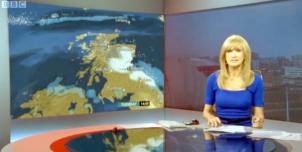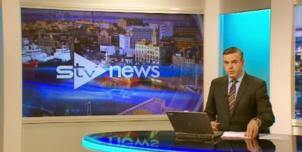Full Freeview on the Durris (Aberdeenshire, Scotland) transmitter
| Google Streetview | Google map | Bing map | Google Earth | 57.000,-2.392 or 56°59'59"N 2°23'30"W | AB39 3TH |
The symbol shows the location of the Durris (Aberdeenshire, Scotland) transmitter which serves 180,000 homes. The bright green areas shown where the signal from this transmitter is strong, dark green areas are poorer signals. Those parts shown in yellow may have interference on the same frequency from other masts.
This transmitter has no current reported problems
The BBC and Digital UK report there are no faults or engineering work on the Durris (Aberdeenshire, Scotland) transmitter._______
Digital television services are broadcast on a multiplexes (or Mux) where many stations occupy a single broadcast frequency, as shown below.
64QAM 8K 3/4 27.1Mb/s DVB-T MPEG2
H/V: aerial position (horizontal or vertical)
Which Freeview channels does the Durris transmitter broadcast?
If you have any kind of Freeview fault, follow this Freeview reset procedure first.Digital television services are broadcast on a multiplexes (or Mux) where many stations occupy a single broadcast frequency, as shown below.
64QAM 8K 3/4 27.1Mb/s DVB-T MPEG2
H/V: aerial position (horizontal or vertical)
Which BBC and ITV regional news can I watch from the Durris transmitter?

BBC Reporting Scotland 2.4m homes 9.2%
from Glasgow G51 1DA, 173km southwest (224°)
to BBC Scotland region - 230 masts.

STV News 0.4m homes 1.5%
from Aberdeen AB12 3QH, 23km northeast (52°)
to STV North (Aberdeen) region - 76 masts.
Are there any self-help relays?
| Aberdeen (old Town) | Transposer | 2 km N city centre | 837 homes (dealer estimate) |
| Aberdeen-talisman | Transposer | 1 km SW city centre | 100 homes |
| Fyvie | Active deflector | 37 km NW Aberdeen | 10 homes Hotel |
| Glen Tanar | Active deflector | 11 km E Ballater | 13 homes |
| Glenlivet | Transposer | 15 km E Grantown-on- Spey | 70 homes School |
| Haughton House C/p | Transposer | 1 km N Aford Aberdeenshire | 1 homes 150 caravans |
| Oyne | Active deflector | 33 km NW Aberdeen | 11 homes |
| Strathdon A | Transposer | 60 km W Aberdeen | 25 homes |
| Strathdon B | Transposer | 25 homes | |
| Strathdon C | Transposer | ‘appreciable population' | |
| Strathdon D | Active deflector | ||
| Strathdon E | Active deflector | ||
| Strathdon F | Active deflector |
How will the Durris (Aberdeenshire, Scotland) transmission frequencies change over time?
| 1961-80s | 1984-97 | 1997-98 | 1998-2010 | 2010-13 | 3 Oct 2018 | ||||
| VHF | A K T | W | W | A K T | W T | ||||
| C9 | ITVwaves | ||||||||
| C22 | BBC1waves | BBC1waves | BBC1waves | BBCB | BBCB | ||||
| C23 | SDN | SDN | |||||||
| C25 | ITVwaves | ITVwaves | ITVwaves | D3+4 | D3+4 | ||||
| C26 | ArqA | ArqA | |||||||
| C28 | BBC2waves | BBC2waves | BBC2waves | BBCA | BBCA | ||||
| C29 | ArqB | ||||||||
| C30 | _local | ArqB | |||||||
| C32 | C4waves | C4waves | C4waves | com7 | |||||
| C35 | com8 | ||||||||
| C41 | _local | ||||||||
| C55tv_off | com7tv_off | ||||||||
| C56tv_off | COM8tv_off | ||||||||
| C67 | C5waves | C5waves |
tv_off Being removed from Freeview (for 5G use) after November 2020 / June 2022 - more
Table shows multiplexes names see this article;
green background for transmission frequencies
Notes: + and - denote 166kHz offset; aerial group are shown as A B C/D E K W T
waves denotes analogue; digital switchover was 1 Sep 10 and 15 Sep 10.
How do the old analogue and currrent digital signal levels compare?
| Analogue 1-4 | 500kW | |
| Analogue 5, BBCA, D3+4, BBCB | (-7dB) 100kW | |
| SDN, ARQA, ARQB | (-10dB) 50kW | |
| Mux 1*, Mux 2*, Mux A* | (-14dB) 20kW | |
| com7, com8 | (-15.4dB) 14.5kW | |
| Mux B* | (-17dB) 10kW | |
| Mux C*, Mux D* | (-20dB) 5kW |
Local transmitter maps
Durris Freeview Durris TV region BBC Scotland STV North (Aberdeen micro region)Which companies have run the Channel 3 services in the Durris transmitter area
|
|
Is the transmitter output the same in all directions?
Radiation patterns withheldFriday, 2 October 2015
J
jb3811:02 PM
John : In addition / alteration to that said. Although as previously mentioned, the Cullingworth area is seen to be well outside the Idle transmitters coverage area (as indicated on the TX's coverage map), however, a Cullingworth test p/code of BD13-5 did indicate that reception was possible in that particular area.
The point which intrigued me was your reference to "everything gone with the exception of 6 German channels", as this points to interference from foreign channels, something which can happen as seasons change, and a possible reason why so many problems are being experienced by viewers residing in the Eastern areas of the UK, whereas not to any great extent elsewhere.
| link to this comment |
Tuesday, 29 December 2015
G
Geoff4:56 PM
Ellon
All HD channels seem to disappear, or transmit intermittently, each Friday, between around 1900 and 2200 hrs. Normally we are getting 100% strength, 30-40% quality. Exception was last week when Friday was ok, but the dropout was, instead, on the saturday. Have only recently upgraded from crt tv to flatscreen, so have no long record of events, but it seems an odd occurrence and just wondered if there was a logical explanation.
Aerial is external, half way up gable-end with clear view to horizon and checked pointing in direction of transmitter, and reception is on a humax hdr pvr.
Location AB41 7NR, just north of Tarves. If it's single channel interference I'm puzzled as to why it only (seems to be) on a Friday?
| link to this comment |
Geoff's: mapG's Freeview map terrainG's terrain plot wavesG's frequency data G's Freeview Detailed Coverage
J
jb388:53 PM
Geoff: If the figures given for the strength and quality of the HD signal are correct, and its not the case of the reverse of, i.e: 30 - 40% strength / 100% quality, then intermittent reception at these levels is something not entirely unexpected as they are quite unacceptable. In order to assess the situation better, what levels are indicated on your SD channels?.
| link to this comment |
Wednesday, 13 January 2016
G
Geoff4:24 PM
Ellon
Geoff: My apologies for the delay in responding. (I was expecting an email notification of a response).
I can't believe it, I got them transposed! Quality should be the higher figure, strength lower. Sd figures for quality are generally 10-20% higher.
It's no longer just on a Friday, but is proving more intermittent as we've discovered since setting up the flat screen. We very rarely watch live, predominantly programs recorded.
| link to this comment |
Geoff's: mapG's Freeview map terrainG's terrain plot wavesG's frequency data G's Freeview Detailed Coverage
Monday, 11 April 2016
K
Kirsty7:33 PM
For the past week both our freeview TVs have been experiencing pixelation, distorted audio and really loud and annoying clicks. I have checked the cables, retuned them, switched off and on again but still no improvement. Is there an issue with durris? Or is there an easy doityourself way of checking our aerial? Thanks
| link to this comment |
Tuesday, 12 April 2016
M
MikeB5:31 PM
Kirsty: Check your signal strength - its too high, or too low, thats the sort of things that happens. If its too high 90% plus, then there are easy ways to fix that. If its too low, your liable to have a problem with your aerial system.
| link to this comment |
MikeB's: mapM's Freeview map terrainM's terrain plot wavesM's frequency data M's Freeview Detailed Coverage
Monday, 2 May 2016
Wednesday, 8 June 2016
J
John Jenkinson2:39 PM
Peterhead
Good Afternoon.
Please can you advise we get interference on BBC one and have weak signal notice on some other channels, we have a modern aerial fitted 18 months ago which runs to a booster in the loft for three tv sets,
as a back up we have a freesat box connected to a dish which works fine.
Looking at the transmitter coverage map for our post code AB42 4HJ Fetterangus we are prone to week signals would that be correct.
I hope this is enough information to get advice.
Kind Regards
John
| link to this comment |
John's: mapJ's Freeview map terrainJ's terrain plot wavesJ's frequency data J's Freeview Detailed Coverage
R
Richard Cooper4:04 PM
Norwich
John Jenkinson: Hi, John. According to the Digital UK Coverage checker, you are most likely to be receiving the Durris transmitter, which is one of the 80'ish MAIN FULL Freeview transmitters and one of those which carries 8 groups of channels, which we call "multiplexes". Digital UK predicts that you will get good reception on 31 channels and variable reception on 78 channels. Good reception is likely on logical channel numbers 1 to 6, followed by good reception also of BBC Alba, as well as BBC4 when BBC4 is on. Examples of variable channels are 'Dave', 'Pick', ITV3, 'Really', Yesterday, 4Music, some of the shopping channels and quite a few more of the less viewed channels. If you have a high definition (HD) receiver, you should also obtain good reception of fifteen HD channels too.It would be interesting for you to post back to say whether this is a good representation of what you are actually finding in practice. The coverage map for the Durris transmitter does indeed have quite a scattered pattern exhibiting a number of holes or dead spots, especially as you go North-Eastwards towards Peterhead and Fraserburgh, i.e. in the direction of Fetterangus. Do please post back with your comments on this post. Richard, Norwich, England, 4 p.m. on Weds. 8th. June.
| link to this comment |
Richard's: mapR's Freeview map terrainR's terrain plot wavesR's frequency data R's Freeview Detailed Coverage
K
KMJ,Derby6:48 PM
John Jenkinson: The COM4, COM5 and COM6 muxes from Durris share frequencies with the PSB muxes from Knock More. This results in low level signals from Knock More causing reductions in signal quality or blocking of reception for viewers of the Durris COMs in affected location a. Sometimes careful positioning of the aerial intended to receive signals from Durris can help in screening out the unwanted interference from Knock More. Any problems affecting BBC programmes are not caused by Knock More, but could be helped by careful aerial positioning. Aim for signal strength less than 90 percent but quality as high as possible, preferably 100 percent.
Also beware of interference from HDMI cables (if fitted) causing problems to individual frequencies.
| link to this comment |
Select more comments
Your comment please!




